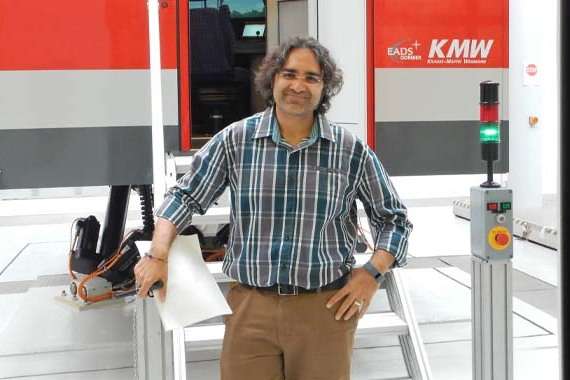Accelerating rail driver training through new tech
Description
An innovative driver-display is being designed to improve rail driver training. The new display will be congruent with the way novice train drivers naturally encode their task and will accelerate the acquisition of route knowledge.
Partners
Sydac
Impact
The research project has shown a need for change to pedagogy in driver training, as well as for new technology. One of the benefits of this project has been the understanding about how expert train drivers use cues from their environment to drive safely and efficiently. In the longer term, this research will address the looming skills shortage facing the industry.
Associate Professor Anjum Naweed
A CQUniversity-led partnership with rail simulator company Sydac is developing an innovative display tool that will accelerate rail driver training and help avert the looming skills shortage in the industry.
The research, led by Associate Professor Anjum Naweed and Associate Prof Matthew Thomas, Deputy Director of CQUniversity's Appleton Institute in Adelaide, aims to design a driver-display that is congruent with the way novice train drivers naturally encode their task and evaluate the extent to which the tool accelerates the acquisition of route knowledge in train drivers.The research, led by Associate Professor Anjum Naweed and Associate Prof Matthew Thomas, Deputy Director of CQUniversity's Appleton Institute in Adelaide, aims to design a driver-display that is congruent with the way novice train drivers naturally encode their task and evaluate the extent to which the tool accelerates the acquisition of route knowledge in train drivers.
The project which commenced in 2013-14, is funded with $380 000 from the Australian Research Council (ARC) as part of the ARC Linkage Scheme and partner contributions. Sydac is a major supplier of driver training simulators in Europe, Asia and Australia.
Professor Naweed says that after developing a series of driver display prototypes, the Appleton Institute's Human Factors and Operational Readiness team (including CQUni RhD student Ganesh Balakrishnan) has developed a final driver-display design.
'Our rail industry has been growing to the point where demand outpaced the supply of drivers, creating a real shortage of skilled staff,' Professor Naweed says.
With concerns about the expediency and efficiency of driver training Professor Naweed looked at psychology and human factors of driving trains in a bid to design a new simulator in conjunction with Sydac.
'Although it may not look like it, train driving is actually an astonishingly complex task. You are responsible for moving many tonnes of weight down a guideway, using steel wheels on steel rails. It can feel slippery and all that weight is much harder to control,' he says.
He says there were many factors a driver had to consider when operating a train and that improving route knowledge was the key to improved driver training.
'The task of the train driver is very three-dimensional. Our research has shown that they tend to think of it in terms of its xyz coordinates … however when the information is presented to drivers in the cab it is generally done using two-dimensional analogues.
'The big problem is that the two-dimensional analogues are not congruous with the basic profile of the task – as a result they can produce a lot of variability in the way drivers 'encode' route information and create inconsistencies in the development of their competencies.'
Train driver training methods, which involved more experienced driver apprenticing new drivers was costly and overlong with learning period of up to 12 months for passenger trains, or 24-36 months for freight trains in Australia.
He says the COVID-19 outbreak has introduced more consideration for training, thrusting the simulator into the spotlight.
'COVID-19 has introduced logistical challenges and lots of safety considerations which means training has had to occur virtually, and more emphasis has been placed on simulator capacity,' he says.
Therefore, simulators continue to offer an improved experience for train driver instruction and the project has developed new simulations, including presenting CGI imagery with enhanced information specific to the trainees learning cycle.
Following many years of interviews with train drivers and driver managers across many different railways including Adelaide Metro, V/Line in Victoria and Transport for NSW, several design concepts for the new driver-displays were developed, tested and trialled on-site at the Appleton Institute.
Professor Naweed says that the project has shown a need for changes to pedagogy, as well as new technology.
'It is not just about technological innovation, rather, the new technologies need to be embedded within new processes for training and skills development – the real benefit of this project is that it has led to a much better understanding about how expert train drivers use cues from their environment to drive safely and efficiently.'
The cues in the real world might then be better conveyed in the simulator environment and embedded within a training framework that fast-tracks this knowledge and skill development. Through the innovative use of the simulator, the team has demonstrated efficiencies in training design that can really help the rail industry.
The project has completed data collection and analysis and lead researchers are currently preparing the results for publication. The final driver display design has been established and the researchers will be working with Sydac to promote it for use in future training.
Connect with CQUniversity
At CQUniversity we know the value of our connections locally and around the world. Our partnerships help us create opportunities, deliver solutions and change lives. From time to time, we share our Connections Count update where we share our highlights, including research impact stories like the ones below. Sign up to become one of our valued connections.

